The
![]() Design
Features
Design
Features
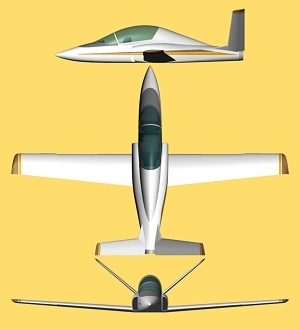 Achieving
speed and efficiency, stability, agility and a slow docile stall requires
very carefully balancing all of the design compromises. This is the great
challenge in designing the
HawkJET™.
Achieving
speed and efficiency, stability, agility and a slow docile stall requires
very carefully balancing all of the design compromises. This is the great
challenge in designing the
HawkJET™.
The reason we have airplanes is to transport people from one place to another. If we could do that without airplanes, we wouldn't need them. Likewise, there is also no need to have more airplane than is required to transport the people that are inside it. This is why the HawkJET™ is relatively small. The space for the people isn't small though, just the airplane around them (there is ample room for two adults well over six feet tall). The relatively small size of the HawkJET™ contributes to its speed, efficiency and agility.
When the auto companies design a
car, one of the primary forces driving the design is styling. The new design must look good. This is also
true of the
HawkJET™
design. Fortunately, smooth, fair lines are already pleasing to the eye just as they are pleasing to the
air. However more attention has been paid to the appearance of the
HawkJET™
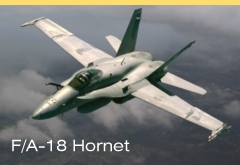 than merely what aerodynamics would dictate. For instance, the V-tail was chosen purely for this styling
aspect. Contrary to some myths, there is little, if any aerodynamic advantage. The
HawkJET™
has a V-tail because of the way it looks. The F/A-18 has outwardly canted twin tails and that is what had me
looking at a V-tail. Again, contrary to popular opinion, there is no inherent handling problem with the V-tail
configuration when it is designed correctly. Apparently V-tails got a "bad rap" from the Dutch Roll characteristics
of the Beechcraft Bonanza. The issue isn’t the V-tail itself, but rather the way it was designed.
than merely what aerodynamics would dictate. For instance, the V-tail was chosen purely for this styling
aspect. Contrary to some myths, there is little, if any aerodynamic advantage. The
HawkJET™
has a V-tail because of the way it looks. The F/A-18 has outwardly canted twin tails and that is what had me
looking at a V-tail. Again, contrary to popular opinion, there is no inherent handling problem with the V-tail
configuration when it is designed correctly. Apparently V-tails got a "bad rap" from the Dutch Roll characteristics
of the Beechcraft Bonanza. The issue isn’t the V-tail itself, but rather the way it was designed.
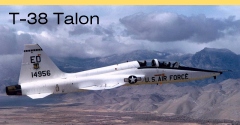 The T-38 Talon has a very beautiful
and graceful shape. This beauty and grace heavily influenced the shape of the
HawkJET™.
Incorporating a V-tail with these elegant lines, then gives the
HawkJET™
a look all its own. The selection of the V-tail also influences the shape of the empenage. The F/A-18 is a
twin engine jet so it has a fairly wide aft fuselage on which the tails are mounted. Except for the narrow
aft fuselage, there is some similarity to the turtledeck, aft fuselage and tail of the
HawkJET™.
As a result, all of this gives the
HawkJET™
the sleek visual qualities of a modern fighter jet.
The T-38 Talon has a very beautiful
and graceful shape. This beauty and grace heavily influenced the shape of the
HawkJET™.
Incorporating a V-tail with these elegant lines, then gives the
HawkJET™
a look all its own. The selection of the V-tail also influences the shape of the empenage. The F/A-18 is a
twin engine jet so it has a fairly wide aft fuselage on which the tails are mounted. Except for the narrow
aft fuselage, there is some similarity to the turtledeck, aft fuselage and tail of the
HawkJET™.
As a result, all of this gives the
HawkJET™
the sleek visual qualities of a modern fighter jet.
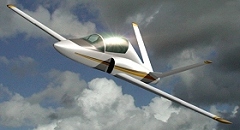
In addition to having
such an appealing shape, the
HawkJET™
features design innovations in the areas of Utility and Affordability, Aerodynamic Optimization and
Controllability, and Materials Selection and Construction.
Utility and Affordability
In the past fifteen or twenty years the number of new, certified, factory-built production aircraft that have been registered with the FAA has been fewer than the number of new homebuilt aircraft. There are a number of factors contributing to this. A couple of these factors are the superior performance and reduced operating costs of the homebuilts. There is currently a movement in General Aviation toward smaller jets – “Very Light Jets” – jets like the Eclipse 500 that are about the size of say, a Cessna 310 or a Beachcraft Baron. Interestingly, the 310 and Baron are among the same aircraft being displaced by smaller, high performance propeller driven homebuilts.
The vast majority of private aircraft flights carry between one and two people. This also tracks with the fact that the vast majority of homebuilt aircraft are two place aircraft. The HawkJET™ is intended to “fit right in” as a two place aircraft along with the current trend toward small jets.
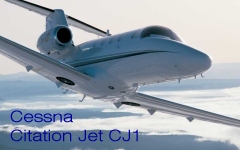 Other aircraft that are similar
to the
HawkJET™
use turbojet engines that are noisy and thirsty. The FJ44 FanJet used in the
HawkJET™
is the quietest production jet engine currently being manufactured. This is the engine that equips the Cessna
Citation CJ1 and this is well known as a quiet airplane. Also, since it is a FanJet and not a turbojet, it
is among the most fuel-efficient. After all, the late Steve Fossett flew the FJ44 powered Virgin Atlantic
GlobalFlyer around the world on one tank of gas. And he did it two different times!
Other aircraft that are similar
to the
HawkJET™
use turbojet engines that are noisy and thirsty. The FJ44 FanJet used in the
HawkJET™
is the quietest production jet engine currently being manufactured. This is the engine that equips the Cessna
Citation CJ1 and this is well known as a quiet airplane. Also, since it is a FanJet and not a turbojet, it
is among the most fuel-efficient. After all, the late Steve Fossett flew the FJ44 powered Virgin Atlantic
GlobalFlyer around the world on one tank of gas. And he did it two different times!
There are a variety of fast, high performance propeller-driven homebuilt aircraft. Unfortunately, while achieving their high cruise speed, these airplanes also tend to have a fairly high landing speed. Two notable exceptions are the Lancair Legacy and the Questair Venture. These planes were designed to meet the FAA stall speed requirement of 61 knots (70 mph) for factory-built production aircraft of this type. The HawkJET™ is also designed to meet this standard giving it an unprecedented level of safety for any jet. As a side benefit, the HawkJET™ will be capable of operating from relatively small airports while also being quiet enough that it won’t disturb the neighbors. All this gives the HawkJET™ unequalled versatility!
Among other features that add to the HawkJET’s™ utility is a pressurized cabin. It is designed to provide a pressure differential of 5 psi, which will allow for an 8,000 foot cabin altitude while the HawkJET™ is cruising at 25,000 feet. By eliminating the need to use cumbersome oxygen masks, this greatly increases the comfort of the crew while flying in the Flight Levels that allow for flight above most of the weather. A design practice used in military trainers is to elevate the rear seat to give the “instructor” ample forward visibility. This is also done with the HawkJET™, giving the rear-seated crewmember a clearer view to aid in piloting from that seat.
Internal antennas are incorporated into the wingtips and the forward fuselage to eliminate the parasite drag of external antennas. The control system consists of push-pull tubes for actuation to provide precise, solid control. The retractable landing gear is actuated hydraulically using proven aircraft components. Fuel is contained in "wet" wings for additional safety (there is no fuel in the fuselage).
Quiet operation, low landing speed, pressurized cabin and super visibility contribute to the overall utility of the HawkJET™. Add to this the reliability of a modern FanJet engine, plus its relatively low fuel consumption while traveling at 350 knots and you get a sense of the relatively low cost of operating this innovative jet. In this era of long lines at security checkpoints, the inconvenience of airline schedules and a relatively small number of airports serviced by those airlines, a personal jet like the HawkJET™ is truly a big advantage.
Aerodynamic Optimization and Controllability
The mission of an aircraft has a great deal to do with its design. Likewise, the design of the HawkJET™ is a reflection of the intended mission. The intended mission is to provide an efficient cruise of 350 knots at 25,000 feet altitude, a slow docile stall with superb handling qualities and an excellent rate of climb. Obviously minimum drag is a priority to achieve this efficiency and the HawkJET™ uses other clever tricks for low speed handling along with minimum stall speed.
You may have heard it said "The wing is the thing." A lot of what has the HawkJET™ achieve it's high performance is the wing. Its high aspect ratio (10.5:1) reduces wing area while maintaining the wing span. This reduces induced drag and maintains good rate-of-climb and high altitude performance. It also means the wing chord is smaller, which affects the stability because it makes the tail more effective.
 The
HawkJET™
airfoil is designed to be almost 50% laminar on the upper surface and 70% laminar on the lower surface,
again reducing drag. The upper surface of the wing is the hardest area to maintain laminar flow so this
airfoil is designed to take advantage of the lower surface's natural tendency. This airfoil also has a
positive moment coefficient (most are negative). The result is the tail doesn't have to counteract the usual
nose-down pitching force from the wing. All of this provides less drag for more efficiency and the positive
pitching moment gives more stability for a given tail size.
The
HawkJET™
airfoil is designed to be almost 50% laminar on the upper surface and 70% laminar on the lower surface,
again reducing drag. The upper surface of the wing is the hardest area to maintain laminar flow so this
airfoil is designed to take advantage of the lower surface's natural tendency. This airfoil also has a
positive moment coefficient (most are negative). The result is the tail doesn't have to counteract the usual
nose-down pitching force from the wing. All of this provides less drag for more efficiency and the positive
pitching moment gives more stability for a given tail size.
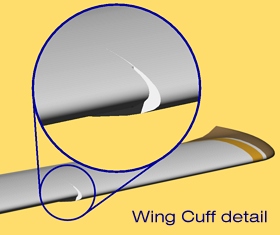 The wing plan-form has a major
effect on the stall characteristics. The more the wing is tapered, the higher the tendency for the wing tips
to stall first (with the corresponding loss in aileron control). The
HawkJET™
has only moderate taper, which reduces the chance of the tip stalling first. The outer wing also has a
"cuff" like the one developed for the Questair Venture and the Cirrus SR20. This cuff is an abrupt change in
the leading edge plan-form of the wing. There is also a small slot in the leading edge at the juncture of
the cuff (it looks as if someone began a saw cut in the leading edge of the wing). Together they cause a
vortex to be formed over the wing at high angles of attack. This vortex interacts with the upper surface
airflow and keeps the wing tips "flying" deep into the stall, thus providing positive aileron control at
very low airspeeds.
The wing plan-form has a major
effect on the stall characteristics. The more the wing is tapered, the higher the tendency for the wing tips
to stall first (with the corresponding loss in aileron control). The
HawkJET™
has only moderate taper, which reduces the chance of the tip stalling first. The outer wing also has a
"cuff" like the one developed for the Questair Venture and the Cirrus SR20. This cuff is an abrupt change in
the leading edge plan-form of the wing. There is also a small slot in the leading edge at the juncture of
the cuff (it looks as if someone began a saw cut in the leading edge of the wing). Together they cause a
vortex to be formed over the wing at high angles of attack. This vortex interacts with the upper surface
airflow and keeps the wing tips "flying" deep into the stall, thus providing positive aileron control at
very low airspeeds.
The wing flaps are the major part of the lower stall speed of the HawkJET™. True fowler flaps are used. Most general aviation aircraft use slotted flaps which have only a small amount of aft movement when deployed. The flaps on the HawkJET™ are 25% of the wing chord and when deployed, move aft the full 25%. This increases the wing area along with the added camber of the drooped flaps, in turn reducing the stall speed several more knots.
Material Selection and Construction
The HawkJET™ is designed to be light. Even with today's infatuation with composite materials, unless you spend at least ten times the money, aluminum provides a lighter structure. John Roncz added a 10% penalty to the weight estimates when designing his airplane with composites. Jim Griswold, the designer of the Questair Venture, said it is for this reason that the Venture is aluminum. About two thirds of the HawkJET™ structure is aluminum. Light weight contributes to a higher rate of climb and slower stall speed and increases control responsiveness.
A major contributor to low aerodynamic drag is how accurately the airplane conforms to the design shape. For example, it has long been said that achieving the designed laminar flow on a metal wing (even when flush riveted) is not likely. This is due to many factors, not the least of which is the distortion of the aluminum skin during the riveting process.
 The
HawkJET™
has been designed with things like this in mind. Therefore heavy reliance of Computer Aided Design/Computer
Aided Manufacturing (CAD/CAM) technology is utilized. The entire airplane is originally assembled in the
“virtual” environment of the computer using state-of-the-art solid modeling software. This allows for
fewer parts being scrapped and faster more accurate fabrication of these parts. These solid models are also
used with Finite Element Analysis (FEA) programs to optimize the strength and weight.
The
HawkJET™
has been designed with things like this in mind. Therefore heavy reliance of Computer Aided Design/Computer
Aided Manufacturing (CAD/CAM) technology is utilized. The entire airplane is originally assembled in the
“virtual” environment of the computer using state-of-the-art solid modeling software. This allows for
fewer parts being scrapped and faster more accurate fabrication of these parts. These solid models are also
used with Finite Element Analysis (FEA) programs to optimize the strength and weight.
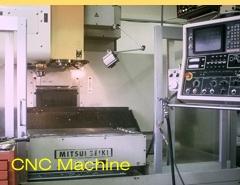 The materials are selected to
facilitate the optimization of ease-of-construction (given the level of fabrication equipment available) and
weight savings. Aluminum is used as much as practicable. Adhesive bonding methods will be incorporated
to alleviate much of the riveting. Moldless, room temperature curing composite materials and methods will be
used where complex shapes are required. The foam cores of these shapes will be contoured using Computer
Numerical Controlled (CNC) equipment.
The materials are selected to
facilitate the optimization of ease-of-construction (given the level of fabrication equipment available) and
weight savings. Aluminum is used as much as practicable. Adhesive bonding methods will be incorporated
to alleviate much of the riveting. Moldless, room temperature curing composite materials and methods will be
used where complex shapes are required. The foam cores of these shapes will be contoured using Computer
Numerical Controlled (CNC) equipment.